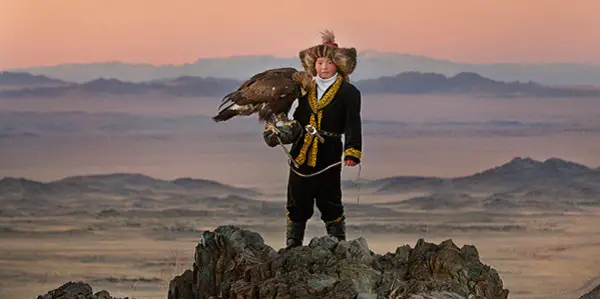With thick black braids and round cheeks burned apple red from the wind that sweeps across the Mongolian steppe, thirteen-year-old Aisholpan Nurgaiv doesn’t look like your stereotypical hardened hunter. However, this daughter of Kazakh nomads is much tougher than she initially appears. Aisholpan dreams of following in the footsteps of her father, and so many generations of his fathers before him, by becoming an eagle hunter and competing in Mongolia’s famous Golden Eagle Festival, an annual tradition that draws tourists from around the world.
Female eagle hunters are few and far between, and none have ever entered the competition, let alone won it. But that doesn’t stop Aisholpan. After all, just because no woman has done it before doesn’t mean she can’t be the first. With the support of her father and a lot of hard work, she sets out to make her dream a reality. If she’s successful, she will accompany her father into the mountains to hunt for animals whose meat and fur will sustain her family through the long winter.

Aisholpan’s extraordinary journey is the subject of The Eagle Huntress, a feature-length documentary directed by Otto Bell and executive produced by Daisy Ridley, who also serves as narrator. This makes sense: Ridley, who became a role model for young girls everywhere after her performance as the heroic Rey in Star Wars: The Force Awakens, is the perfect person to tell this real-life story of female empowerment. Just as Rey showed girls that they too could wield a lightsaber, Aisholpan shows us that girls are capable of taking on other traditionally male pursuits and excelling at them.
Anything You Can Do, She Can Do Better…
How capable is Aisholpan? She scales a cliff to capture her own eaglet to raise. She rides for miles on horseback to the festival with the fifteen-pound bird resting on her arm the entire way. She keeps her cool in competition against men four times her age. In addition to her dreams of becoming an eagle huntress, she also wants to be a doctor when she grows up. She’s a remarkable young woman, aided in her quest by a remarkable feminist father, Rys Nurgaiv, who supports Aisholpan one hundred percent even as he worries about how the male eagle hunters will treat her.
For a man raised in a culture that on the surface may seem old-fashioned, Rys has an entirely modern view of gender equality that men around the world would do well to emulate. He knows that his daughter can do anything she sets her mind to, and he dedicates himself to helping her do it.
As any woman who has ever broken barriers will tell you, in order to succeed as a woman in a male-dominated field, you cannot be just as good as the men – you have to be better. Rys knows this too, and devotes time and energy to ensuring that his daughter is more than just a novelty act at the festival. He knows that to be taken seriously by the other hunters, many of whom firmly believe a woman’s place is in the home, not at the hunt, she will have to prove herself at a higher level than a male hunter would.
The most touching moments in The Eagle Huntress come during the festival, as Aisholpan calmly proceeds through one challenge to the next while her father trembles with fear and anticipation for her. His alternating anxiety and exhilaration for her are both contagious; it’s impossible not to walk away from The Eagle Huntress feeling elated and inspired by both daughter and father.
Apart from Aisholpan, the other star of The Eagle Huntress is Simon Niblett’s utterly gorgeous cinematography. The film uses sweeping shots to capture all of the wild, natural beauty of the Mongolian landscape, from the wide empty plains of the steppe to the jagged peaks and cliffs of the mountains, giving Aisholpan’s journey a particularly epic feel. Yet the camera also gets intimate, bringing the audience inside the family yurt and Aisholpan’s boarding school. One does wish that there was a more in-depth exploration of the nomadic culture of the Mongolian steppes, a world so unique and so foreign to so many moviegoers; the film focuses on eagle hunting to the exclusion of other cultural practices.
The Heroine’s Journey, Archetypes and All
The story of Aisholpan’s against-the-odds success is a good one – almost too good to be true. While The Eagle Huntress is described as a documentary, many scenes feel staged for the camera. The arc is too neat, a heroine’s journey straight out of Screenwriting 101 with every beat timed for maximum emotional impact.
The montage of crusty old men spewing sexist views that Bell uses to show what Aisholpan is up against feels particularly heavy-handed, as though Bell was worried that Aisholpan’s quest wasn’t engaging enough on its own and wanted to throw additional obstacles in her path. Certain sequences unfold so perfectly from initial difficulty to happy resolution that it’s very hard to believe that they were entirely spontaneous.
Despite the debate over how much of The Eagle Huntress was exaggerated or reenacted for dramatic effect, Aisholpan’s story is still a powerful one. One cannot underestimate the importance of reminding girls around the world that if they work hard and believe in themselves, they can make their dreams come true. The Eagle Huntress may not follow the proper etiquette of documentary filmmaking, but that doesn’t mean it isn’t a great movie.
What do you think? Does The Eagle Huntress embrace too many tropes to feel like a realistic documentary? Share your thoughts in the comments.
The Eagle Huntress is now available on DVD and streaming services.
Does content like this matter to you?
Become a Member and support film journalism. Unlock access to all of Film Inquiry`s great articles. Join a community of like-minded readers who are passionate about cinema - get access to our private members Network, give back to independent filmmakers, and more.